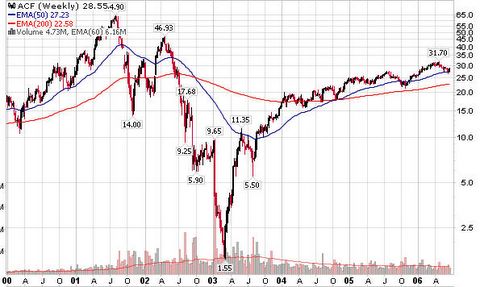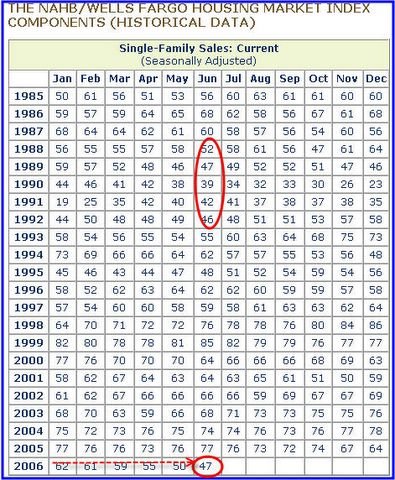May 10th FOMC Statement
The Federal Open Market Committee decided today to raise its target for the federal funds rate by 25 basis points to 5 percent.June 29th FOMC Statement
Economic growth has been quite strong so far this year. The Committee sees growth as likely to moderate to a more sustainable pace, partly reflecting a gradual cooling of the housing market and the lagged effects of increases in interest rates and energy prices.
As yet, the run-up in the prices of energy and other commodities appears to have had only a modest effect on core inflation, ongoing productivity gains have helped to hold the growth of unit labor costs in check, and inflation expectations remain contained. Still, possible increases in resource utilization, in combination with the elevated prices of energy and other commodities, have the potential to add to inflation pressures.
The Committee judges that some further policy firming may yet be needed to address inflation risks but emphasizes that the extent and timing of any such firming will depend importantly on the evolution of the economic outlook as implied by incoming information. In any event, the Committee will respond to changes in economic prospects as needed to support the attainment of its objectives.
The Federal Open Market Committee decided today to raise its target for the federal funds rate by 25 basis points to 5-1/4 percent.As much as I try, I see little difference between these statements. Now doubt some that are perfectly fluent in "Fed Speak" will disagree but the biggest differences that I can spot are the following sentences (all from the statement on June 29th). "Economic growth is moderating", "Readings on core inflation have been elevated in recent months", and "high levels of resource utilization and of the prices of energy and other commodities have the potential to sustain inflation pressures."
Recent indicators suggest that economic growth is moderating from its quite strong pace earlier this year, partly reflecting a gradual cooling of the housing market and the lagged effects of increases in interest rates and energy prices.
Readings on core inflation have been elevated in recent months. Ongoing productivity gains have held down the rise in unit labor costs, and inflation expectations remain contained. However, the high levels of resource utilization and of the prices of energy and other commodities have the potential to sustain inflation pressures.
Although the moderation in the growth of aggregate demand should help to limit inflation pressures over time, the Committee judges that some inflation risks remain. The extent and timing of any additional firming that may be needed to address these risks will depend on the evolution of the outlook for both inflation and economic growth, as implied by incoming information. In any event, the Committee will respond to changes in economic prospects as needed to support the attainment of its objectives.
It seems that one can make a case that the Fed is even more concerned about inflation now as compared to last month. Is a moderating economy with commodity prices having a potential to sustain inflation a good thing? On that note the telepathic question lines are now open. Hmmmm. I am being flooded with the same question repeatedly. "Ok Mish, so why did the market rally?" The answer in a nutshell is that it was ready to. I doubt it had anything to do with anything the Fed said. Ask yourself, would the rally been any bigger if the Fed paused? Would the market have rallied if the Fed did 50 basis points and signaled a pause? Was the market going to drop if the Fed left the language exactly the same? The odds are that the market rallied because it was deeply oversold and selling pressure simply dried up. In short, Bernanke should get no more blame for the May selloff than he gets credit for today's rally: none.
The first thing people need to realize is that the Fed is not really in control of interest rate policy. Like it or not, this is a global economy and the Fed can not dictate world policy or the reactions of its policy decisions to the world. Borrowers simply do not get to dictate terms to lenders. We are at a point where the market (both here and abroad) may force Bernanke to hike far more than he wants to. In fact, I suspect it already has.
I found it interesting that there were nearly identical comments expressed on both Silicon Investor and the Motley FOOL (by multiple people) stating "Bernanke got the reaction that he wanted". My immediate reaction was "Oh Really?". I find it hard to believe that Bernanke wanted a sharp rally in copper, gold, oil, and a bunch of "riskloves" plowing back into carry trades they were rattled out of in the last couple weeks. Unless things fall to pieces in a hurry, look forward to hike number 18 in August. By the time the Fed actually pauses it is likely to be "sell the news event" as the economy will then be clearly and significantly deteriorating.
A recession now is sealed in the books and Bernanke will take the blame. Yes he and Greenspan deserve 100% of the blame for this mess but it will be for the exact opposite reason that most will attribute the recession to.
Peter Schiff discussed this idea today in The Reality of Stagflation.
Now that the Fed has raised rates to 5.25%, and has left the door open for future increases, the overriding concern is that over-tightening will tip the economy into recession. However, given the state of our imbalanced economy, a recession is not only inevitable, but absolutely necessary, and will occur no matter what the Fed does. Furthermore, the coming recession will not come about because the Fed went too far, but because it did not go far enough.That is certainly a well written article but Mish readers know I hate that last sentence. All roads simply do NOT lead to stagflation. However all roads do lead to "something undesirable". I prefer to use the term "Economic Zugzwang" to describe the situation Bernanke is in.
The U.S. economy suffers from extreme economic imbalances that must be resolved. The longer they persist, the more difficult and painful their ultimate resolution will be. The imbalances result primarily from an excess of consumption and borrowing, and insufficient savings and production, and can only be resolved by less of the former and more of the latter.
When the recession occurs it will not be the result of the recent run of Fed rate hikes, but the irresponsible manner in which it lowered them, and kept them low, in the first place.
If Bernanke tries to borrow from Greenspan�s playbook and attempts to prevent or mitigate the severity of the coming recession, the excess liquidity will not simply move into another asset class, as it did from stocks to real estate, but into real stuff, such as commodities and consumer goods. As far as the Fed is concerned, it has now reached a monetary divide where all roads lead to stagflation.
I was listening to Bloomberg today (typically I only listen on FOMC days or if some other major news is happening), and one of the bulls was harping how he "just does not get it". He thought stocks should be way, way higher. As evidence he was pointing out record numbers of mergers and acquisitions and leveraged buyouts. "We have not seen this kind of activity since 2000" he said. I almost burst out laughing. "This was supposed to be an argument FOR a rally?" I wondered. Yes, indeed we are seeing the same kind of speculation as we saw in 2000. The Finacial Times is reporting Volume of IPOs hits $100bn in first half
A record number of billion-dollar deals pushed the size of the global market for initial public offerings in the first half of the year to more than $100bn � second only to the first half of 2000 at the height of the dotcom boom.
Some of the biggest deals were priced in the second quarter, before the recent downturn. For the first six months of the year, the volume of IPOs jumped 56 per cent to $102.2bn, from $65.4bn over the same period in 2005, according to figures from Dealogic.
The talking head on Bloomberg asked "What is it they know that the average investor does not?". My reply would be "They probably know about as much as they did in 2000", which is to get those IPOs on the market while suckers are willing to pay inflated prices for them.
At any rate, this is exactly the kind of mentality the Fed is fighting right now. Corporations are going into debt to buy back shares, we are back in merger mania, IPO mania, and "riskloves" are plowing back into carry trades on any excuse.
Then again perhaps I am giving the Fed way too much credit. They certainly do not deserve much (if any) credit. But neither does anyone commenting about merger activity and comparing it to 2000 without seeing the obvious irony of the comparison.
Let's consider a more rational analysis. On June 9th Paul Kasriel at the Northern Trust wrote The More Things Change, The More They Stay The Same.
As this is being written, the yield on the 10-year Treasury note is 5% - the same as the FOMC�s fed funds rate target. Over the past 50 years or so, this spread has averaged approximately 90 basis points. And, coincidentally, a spread of 90 basis points has been associated with real GDP growth of about 3-1/2%.Unit Labor Chart
As this spread went below 90 basis points in this cycle, the conventional wisdom was that �it was different this time.� This also was the conventional wisdom back in early 2000 when the spread breached the 90 basis point barrier. Little did the consensus know back in early 2000 that the U.S. economy was sliding toward a recession.
But wait a minute. How can we be talking about below potential economic growth when the latest real GDP data (Q1:2006) show annualized growth of 5.3%? As we have written, GDP is a terrific coincident indicator, but a lousy leading indicator. In this linked commentary, we pointed out that after real GDP grew at 6.4% in Q2:2000, it did not reach 3% or higher growth again until Q2:2003 � three years later! As things now stand, we see real GDP growth running at 2-1/2% over the remaining three quarters of this year � assuming the FOMC gets one more 25 basis point rate hike out of its system on June 29.
We want to close with a word about stagflation. We would not characterize the current U.S. economic environment as one of stagflation. Rather, what we are observing today is a typical response to a progressively more restrictive monetary policy. That is, growth in aggregate demand is slowing as that lagging indicator, price inflation, continues to rise for a bit. The stagflation of the 1970s was accompanied by sharply rising unit labor cost growth. As the chart below shows, this is not the case today.
Highlights in blue and red added by Mish

That chart together with the negative savings rate shows the stress the average person is facing. Real wages are falling yet costs are rising everywhere. The one source of jobs is housing and housing is faltering. Yet as long as money is willing to plow into risk at the slightest provocation (like today), Bernanke may have no choice other than to keep hiking.
VIX
Let's look at this rally from the point of view of the VIX.

The VIX is almost but not quite back to the level the S&P 500 was at when the trouble all started. Yet the index is nearly 50 points lower. Is this a good thing? I guess it remains to be seen but the number of big up days immediately reversed (and vice versa) does not seem to be healthy market action to me.
Meanwhile Big Ben's Musical Band keeps cranking out hit after hit. As long as the market is going to react like this to hikes, he is likely to be forced to keep playing "Those Rate Hike Tunes". Last month people thought Bernanke was playing Taps but today the same message sounded more like Reveille. The reality is nothing much has changed except that interest rates are now another 25 basis points higher, the yield curve has inverted for the second time in six months, housing has stalled, and the recession of 2007 is looming ever larger.
Mike Shedlock / Mish
http://globaleconomicanalysis.blogspot.com/













